Wondering whether it’s possible to save money on an expensive water filter and make your own water filtration solution at home? Or has your town been issued with a boil water notice, and you’re wondering how you can make your water safe in the short term?
In this article, we’ve shared the 8 best natural methods of at-home water filtration. Most methods just need a few basic pieces of equipment – and, of course, a water source.
📌 Key Takeaways:
- Some of the best ways to purify water naturally at home are boiling water, using UV light from the sun, distilling water, and building your own water filter.
- By filtering contaminated water at home, you can enjoy safe, potable water with reduced contaminants, without the costs of a store-bought filter.
- However, most at-home water filtration methods are time-consuming, and there’s no way to measure the effectiveness of the filtration process. We recommend a store-bought filter if you want a quicker, more guaranteed means of filtering water.
Table of Contents
⚗️ How to Naturally Filter Water At Home: 8 Methods
Below, we’ve shared some of the best ways to purify water naturally in your own home.
1) Boil Your Water
The quickest and easiest method to produce drinkable water from a questionable water source is to boil the water.
Boiling water kills bacteria, parasites, and other microorganisms. It also causes some chlorine to dissolve. Heating your water to a rolling boil for five minutes should kill most pathogens. If your water is likely contaminated, we recommend heating it for ten minutes, just to be sure.
You can use an electric or gas-powered hob to boil water, or, if you don’t have access to this, you can also boil a pot of water over a campfire.
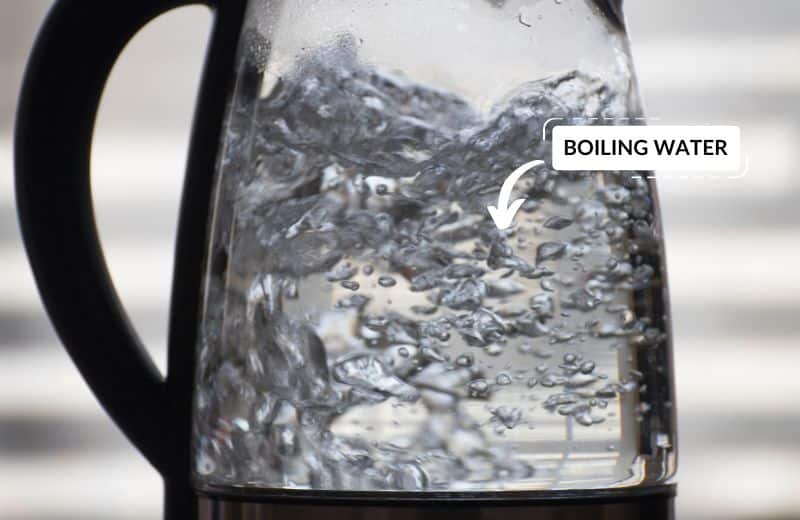
2) Distill Your Water
Boiling water is a good way to kill microorganisms, but it won’t reduce pollutants like radiation, pesticides, or heavy metals like lead from your water. If you’re concerned about your drinking water quality after a natural disaster, distilling your water is the best method of purification.
The water distillation process involves heating water until it forms steam, then capturing and evaporating the steam to produce clean, purified water. Most contaminants have different boiling points to water, which means they’re unable to evaporate and condense with water particles. The exception is some organic compounds and volatile oils.
Indoor Water Distillation (Using Stove)
To make your own at-home water distiller on your stovetop, follow these steps:
- Place a large pot on your stovetop and place a smaller pot or heatproof bowl inside.
- Fill the large pot with water, stopping before the water can overflow into the smaller pot.
- Switch on your stove and place a large, upside-down lid on your big pot. Place ice cubes onto the lid.
- As the water heats up, it’ll condense and form steam. The ice cubes on the lid will cause the steam to quickly cool down as it hits the lid.
- The cooled steam will condense and drip into the small pot.
- Keep adding ice cubes to the lid until nearly all the water has boiled and condensed.
- Voila! You have a small batch of distilled water.
Outdoor Water Distillation (Stove-Free)
If you don’t have access to a stove, don’t panic! You can still distill your water by following these steps:
- Dig a hole in the ground in a part of your garden that gets a lot of sunlight.
- Place a coffee can in the hole, then put green plants around the can. Make sure the plants are slightly damp.
- Cover the hole with plastic wrap, making sure it’s properly sealed. Place a small rock in the middle of the plastic wrap, causing it to dip.
- When the sun comes out, it’ll heat up the hole, causing the water from the damp plants to evaporate. The water will hit the underside of the plastic wrap and drip off the middle, into the coffee can.
- Continue to add more damp plants to the hole until you have enough water to drink.
We’ve shared more information on how to DIY distill water here. 👈
3) DIY Activated Charcoal Filter
Activated charcoal is a popular ingredient in adsorption carbon filters today, thanks to its ability to pull chemicals, tastes, and odors out of water. This type of filter media can also be used to reduce heavy metals and fluoride, though it can’t kill bacteria or viruses.
You can buy activated charcoal as it is from health stores and online (it’s often sold as a food supplement). To use activated charcoal to filter water, pour some of the charcoal powder into a sock, then pour water through the bag and into a clean container.
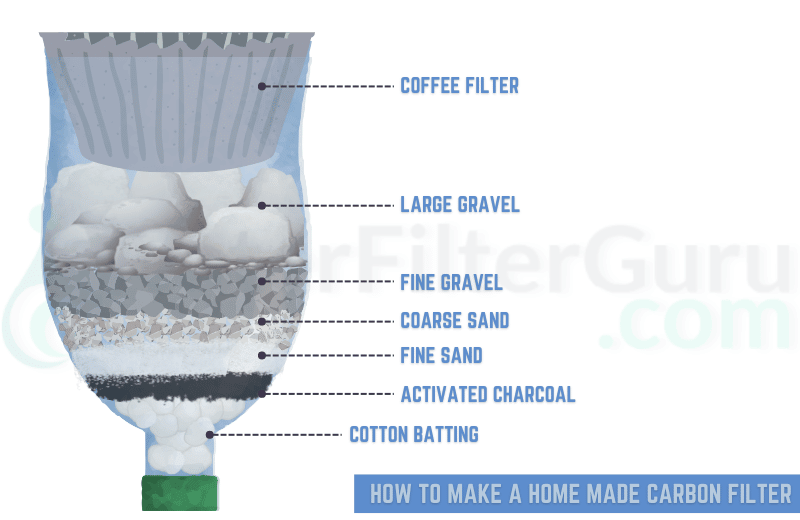
4) DIY Fruit Peel Filter
Some people on the internet claim that fruit peels, like banana and apple peels, are another viable method of DIY water purification. This method can be used in emergencies, and it’s sometimes used in remote regions that have only contaminated water available.
If you didn’t have any other option, you could use the fruit peel filter method to treat your water. But until more research has been released on the effectiveness of fruit peel filtration, we would advise leaving this method as your last resort for now.
5) Build a Pine Wood Water Filter
Building a DIY water filter takes some effort, but it’s possible if you want to replicate the performance of your favorite activated carbon or ceramic water filters.
To make a DIY filter, you just need one or several pine tree branches.
MIT researchers found that pine sapwood offers natural filtration in the wild, filtering air bubbles out of the tree sap and preventing tissue damage.
Take your gathered pine tree branches and peel away the bark. Mount the branches in a piece of tubing (if you have some), with a clean container underneath. Slowly pour water over your DIY purification system. The water should run through the wood, which should filter out particles bigger than 70 nanometers (including nearly all bacteria and other pathogens).
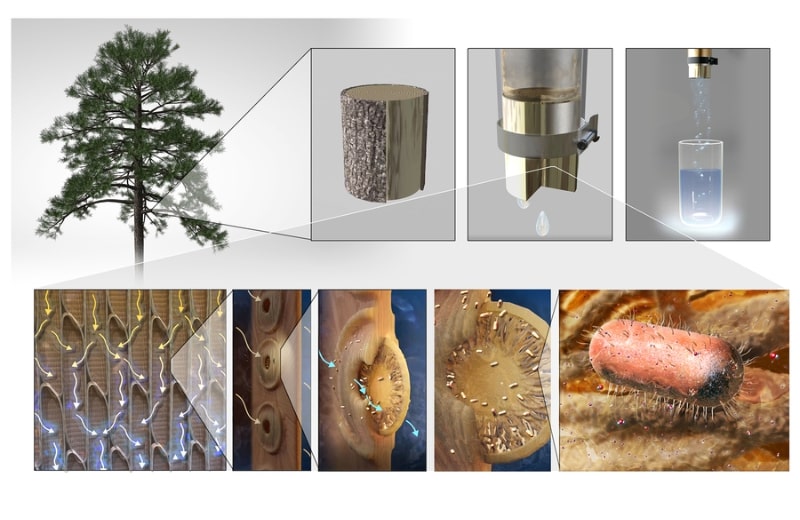
6) Use SODIS
Solar water disinfection (also known as SODIS) is a simple method of water disinfection that uses UV light from the sun.
To treat your water with SODIS, simply fill several clear water bottles with water and leave the bottles in full sunlight for at least 24 hours. The UV light exposure should kill most pathogens, including bacteria and viruses.
SODIS is quick and easy to set up and doesn’t require particular equipment or chemicals, but it doesn’t guarantee complete water purification, and is only effective in sunny weather. Plus, SODIS can’t treat chemically-contaminated water, and it can’t reduce heavy metals.
7) Use Water Purification Drops
If you happen to have water disinfection tablets or drops to hand, you can use these to produce clean drinking water at home.
Some of the common types of water disinfection tablets are made with:
- Chlorine dioxide
- Sodium dichloroisocyanurate
- Iodine
- Tetraglycine hydroperiodide
Just follow the manufacturer’s instructions to dissolve the tablets in your water. Usually, you have to let the water sit for a while before it’s suitable for drinking.
Water disinfection drops add traces of chemical contaminants to your water, but they should at least guarantee safe, clean water that’s free from bacteria and other microorganisms.
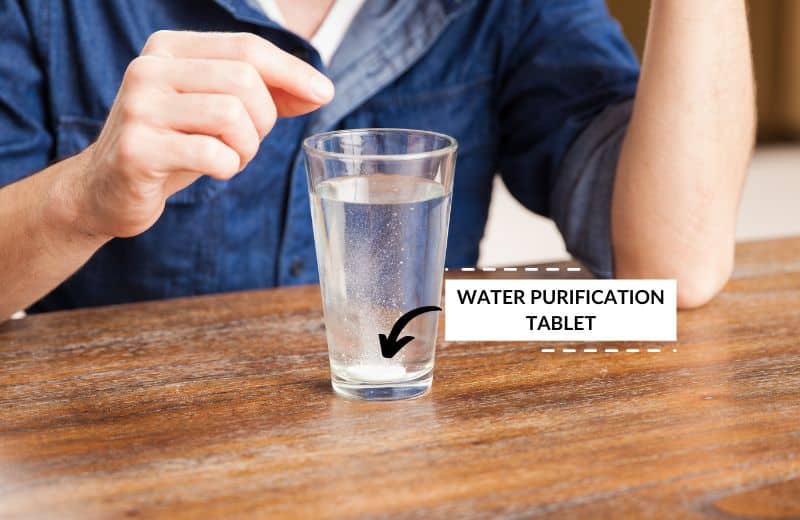
8) Use Natural Chemicals
Using chemicals to purify water isn’t a 100% natural method, but it’s still on our list because it involves items that you probably already have at home.
📌 Iodine and bleach can both be used to disinfect drinking water in emergency situations. You need about 2 drops of unscented liquid bleach per quart of water for effective disinfection. If your water is murky and cold, you may need up to 4 drops per quart.
Follow these steps to disinfect your drinking water with bleach:
- Fill a large container with water and add the appropriate amount of bleach.
- Put the lid on the container and shake the water for two minutes.
- Place the container in a cool, dark location, and leave it for at least 30 minutes.
- You should smell chlorine when you open the lid.
We recommend bleach over iodine since iodine is more harmful to humans. But as a last resort, here’s how to disinfect water with iodine:
- Fill a large container with water and add a suitable amount of iodine (5-10 drops of tincture of iodine 2% per quart of water).
- Close the lid, shake the bottle, and let the water sit for up to 30 minutes in a dark location.
- Your water should now be safe to drink.
Make sure you don’t combine iodine and bleach to disinfect your water, as this won’t be effective.
✅ Why Filter Your Water At Home? 3 Benefits
Now you know the best natural methods of filtering your water at home, you might be wondering whether it’s really worth your time.
📌 Our answer is always: yes! Filtering your water is well worth it, whether you need to make your dirty water supply potable or you just want to remove trace contaminants from chlorinated tap water.
Here are some of the biggest benefits of filtering your water at home:
No More Bottled Water
If your own home’s drinking water supply is filtered, you can simply drink straight from the faucet. No more bulk-buying bottled water to see you through the month. That’s good for your wallet and the environment.
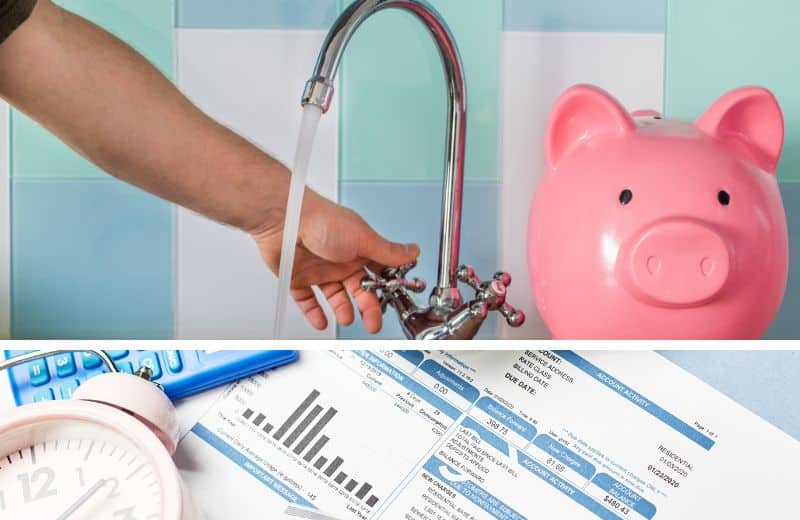
Safe and Drinkable Water
If you’ve been issued a boil water notice or you’re facing a natural disaster, filtering your water at home will ensure that you still have access to a clean, potable source of water. Many methods of at-home filtration remove or kill microorganisms, so you can safely drink your water without the risk of getting sick.
Improves Water Taste and Smell
Even if your water is already deemed “safe to drink” by your local authority, filtering out the trace contaminants like chlorine should give a much fresher, cleaner taste. Most filters retain tasty alkaline minerals in your water, too, so you can keep the good stuff while eliminating the bad.
❌ Setbacks of DIY Filtering Your Water At Home
Not everything about at-home water filtration is positive. If you plan to purify your water at home, make sure you’re aware of the following setbacks.
Time-Consuming
Many of the at-home filtration methods are much more time-consuming than simply using a store-bought water pitcher. You’ll need to set up your equipment, wait for the filtration process to take place, then potentially wait some time before you can drink your water.
No Way To Determine Effectiveness of Filtration
When you filter your water supply with an at-home method, it’s usually not easy to measure the effectiveness of the filtration process. Unless you have a before-and-after water test kit, you won’t know that boiling water has killed the bacteria, for instance. You just have to trust the process.
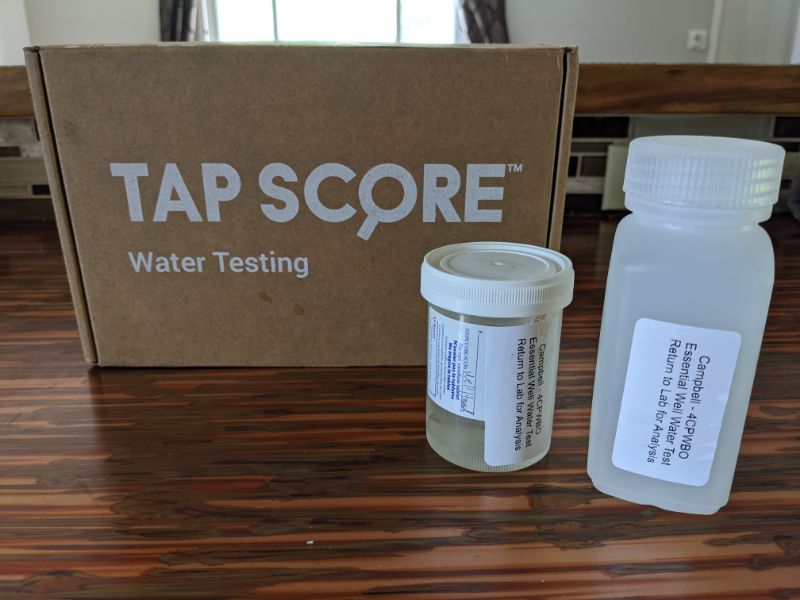
Limited Filtration Capacity
Most methods of purifying water at home can only provide purified water in batches. That’s better than nothing in an emergency situation, but it’s not as convenient as an on-demand solution that produces filtered tap water whenever you need it.
💯 Best Alternative to Natural Filtration: A Ready-to-Use Water Filter
Natural water filters certainly have their advantages. They’re cheap to set up, and are pretty effective at the job you need them for. But they’re also pretty slow, and most methods aren’t guaranteed to be 100% effective.
In our opinion, the best alternative to natural water filtration is to buy a water filter from a store.
Want to buy your own on-demand system? Check out our Top Recommended Water Filters for 2025 here! 👈
This will, of course, cost more money than an at-home solution, and requires some foresight – you’ll need to have the filter already on hand if you want to prepare for potential natural disasters or boil water notices.
But store-bought filters offer a much more guaranteed filtration performance, and they take out the guesswork, too. You don’t have to wonder whether you’ve boiled your water long enough or whether your own handiwork is good enough to keep you safe from common water contaminants.
📌 We think that water filter pitchers are some of the best store-bought water filters for people who want to filter water without spending a fortune. Some of our top picks are the Clearly Filtered Water Pitcher (which can remove more than 365 contaminants) and the Epic Nano Pitcher (which can treat well water and microbiologically unsafe water).
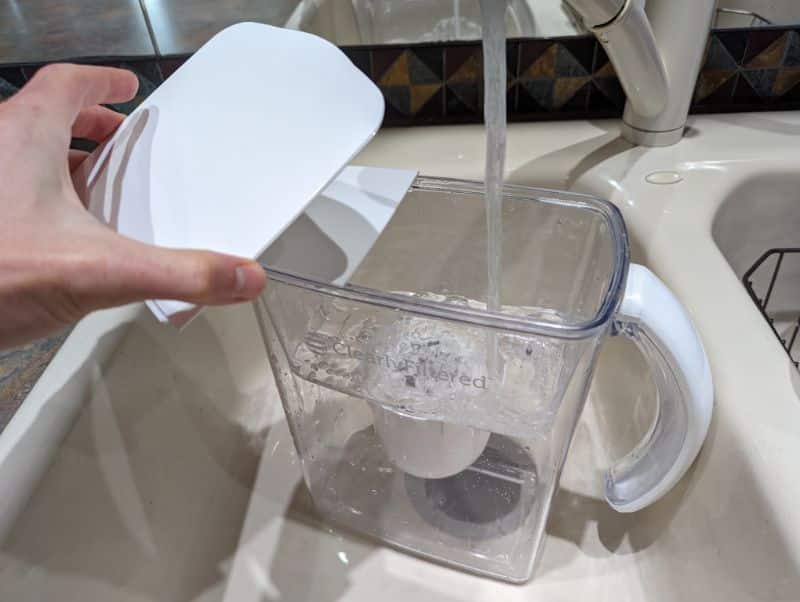
You might also like:
- Learn the Ins and Outs of Filtering Your Water
- Looking for a cheap and portable system? See the 6 Best Water Filter Pitchers of 2025
- Trying to be prepared in case of an emergency? Here are the Best Emergency Prep Water Filters of 2025
❔ How to Filter Water Naturally At Home: FAQ
What is the easiest way to filter water at home?
The easiest way to filter water at home is with a store-bought filter. If you need to purify your water in an emergency situation, boiling it will kill harmful microorganisms.
How do you purify water without a filter?
You can purify water without a filter by distilling it. The easiest way to distill water is to place a small pot in a large pot filled one-third full of water. Place an upside-down lid carrying ice on the large pot and boil the water until it evaporates and condenses back into the small pot.
What natural materials can be used to filter water?
Some natural materials that are thought to be good at filtering water are activated charcoal, pine tree branches, and fruit peeks.

